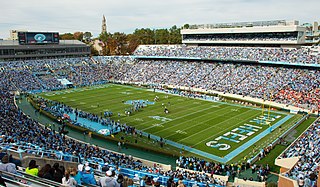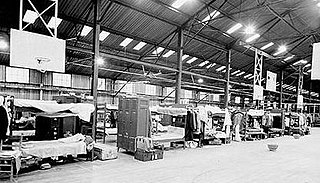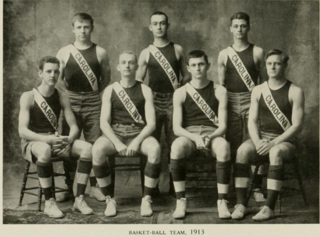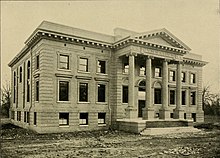
The University of North Carolina at Chapel Hill is a public research university in Chapel Hill, North Carolina, United States. Chartered in 1789, the university first began enrolling students in 1795, making it one of the oldest public universities in the United States.

Kenan Stadium is a college football stadium located on Stadium Drive in Chapel Hill, North Carolina. Opened in 1927, it is home to the University of North Carolina at Chapel Hill's (UNC) football team, which competes in the Atlantic Coast Conference. The facility replaced Emerson Field, where the school's football program had been based since 1916. Plans for the stadium began as attendance increased. Ground was broken on the stadium in December 1926 and work completed in August 1927. The stadium hosted its first game on November 12, 1927, when the Tar Heels faced the Davidson Wildcats, where the Tar Heels won 27–0 in front of 9,000 spectators. On November 24, 1927, the stadium was officially opened and dedicated during a game where the Tar Heels hosted the Virginia Cavaliers and won 14–13.

The Dean E. Smith Student Activities Center is a multi-purpose arena in Chapel Hill, North Carolina, used primarily as the home for the University of North Carolina at Chapel Hill Tar Heels men's basketball team. The university began to inquire about building a standalone arena for the men's basketball team beginning in the mid-1970s, but due to an ongoing university wide investigation, the fundraiser halted until its conclusion. In June 1980, the fundraising began with a goal of at least $30 million and a target completion date for the building of December 1984. It was initially planned to be called the Student Activities Center; however, after its announcement it began to be referred to as The Dean Dome and it was speculated it would be named for then coach Dean Smith. The fundraising concluded in August 1984 with over $33 million raised, but construction would not be finished until 1986. The day before the opening game on January 18, 1986, against the Duke Blue Devils, the building was officially announced to be named the Dean E. Smith Student Activities Center, while a formal dedication happen later in September. In 2018, the hardwood floor of the Smith Center was named for then coach Roy Williams.

Nathaniel John Cartmell, also known as Nat and Nate, was an American athlete who won medals at two editions of the Olympic Games. Importantly, Nate was on first racially integrated Men's Medley relay team that won Olympic gold medal at the 1908 London Olympics, which Nate helped form and featured Nate's fellow University of Pennsylvania alumnus and former teammate, Dr. John Baxter Taylor Jr., the first black athlete in America to win a gold medal in the Olympics. Nate is also known for being the first head coach of the North Carolina Tar Heels men's basketball team

William Donald Carmichael Jr. Arena is a multi-purpose arena on the campus of the University of North Carolina at Chapel Hill in Chapel Hill, North Carolina, United States. It is home to four Tar Heels athletic teams: women's basketball, volleyball, women's gymnastics, and wrestling. It is named for William Donald Carmichael Jr., a popular former school vice-president and brother of All-America basketball player Cartwright Carmichael.

The Indoor Athletic Court was the home of North Carolina Tar Heels men's basketball team from January 8, 1924, through February 17, 1938, across fifteen seasons. Due to increased demand for viewing the varsity basketball team and limited capacity at then home court Bynum Gymnasium, the university appropriated $54,482.45 to have a structure built to house the team. Then Graduate Manager of Athletics Charles T. Woollen decided to build a temporary structure with those funds and a more permanent venue later. Plans were purchased and work began in October 1923. The building, which was a completely steel structure, was built with galvanized steel sheet siding and roof. Many felt the building did not have an attractive exterior. The building featured one bathroom, no locker or dressing rooms, and no heating system, initially. Quickly the building earned a reputation for being cold during the winter and hot during the summer time. An official heating system and, later individual heaters, were added to the building, but did not help the temperature problem. The men's basketball team moved to the Woollen Gymnasium in 1939.

The North Carolina Tar Heels Men's basketball program is a college basketball team of the University of North Carolina at Chapel Hill. The Tar Heels have won six NCAA championships in addition to a 1924 Helms Athletic Foundation title (retroactive). North Carolina has won a record 133 NCAA tournament matchups while advancing to 31 Sweet Sixteen berths, a record 21 Final Fours, and 12 title games. It is the only school to have an active streak of reaching the National Championship game for nine straight decades and at least two Final Fours for six straight decades, all while averaging more wins per season played (20.7) than any other program in college basketball. In 2012, ESPN ranked North Carolina No. 1 on its list of the 50 most successful programs of the past fifty years.

The Charles T. Woollen Gymnasium is a building used for physical education classes, recreational activity for students, and office spaces. It was the home of North Carolina Tar Heels men's basketball team from January 2, 1939, through February 27, 1965, across twenty-six seasons. Due to increased demand for viewing the varsity basketball team and limited capacity at then home court the Tin Can, school president Frank Porter Graham and Charles T. Woollen requested public funds for a new gymnasium and women's dormitory. After being rejected at the federal level, the North Carolina Public Works would award a grant of $283,090 to build a new gymnasium and the school would have to fundraise to cover the cost's remainder. The plans for the building included multi–level building that included an attached swimming pool, along with a main lobby that would overlook the main gymnasium area. Construction stretched from 1937 to 1938 and, upon completion, was seen as "modern" and one of the highest–quality basketball facilities in the Southern Conference.

Herron Gymnasium was a gymnasium and classroom building on the Miami University campus in Oxford, Ohio. Later known as Van Voorhis Hall, it was listed in the National Register of Historic Places in November 1979. Originally conceived in 1893, it was constructed in 1897 and named for John W. Herron, a Miami alumnus and Cincinnati judge. It was Miami University's first gymnasium, and would serve as the main recreational center until the construction of Withrow Court in 1932, which led Herron to become a women's gym. Except for an interlude during World War II when it served as a Navy barracks, it served as a women's gym until the construction of "New Herron" in 1962. In the late 20th century its use diminished to AFROTC and men's intramural sports, and the gymnasium was demolished in 1986 and replaced with a parking lot.

John Blackwell "Sprat" Cobb was an American college basketball player at the University of North Carolina at Chapel Hill. Cobb is one of eight Tar Heels basketball players who have had their jersey retired, and was nicknamed "Mr. Basketball".

The 1956–57 North Carolina Tar Heels men's basketball team was the varsity college basketball team that represented the University of North Carolina. The head coach was Frank McGuire. The team played its home games at Woollen Gymnasium in Chapel Hill, North Carolina, and was a member of the Atlantic Coast Conference. The team was the second undefeated national champion in NCAA basketball history and was the first ACC team to win a title. The team notably won its last two games in triple overtime. The Tar Heels leading scorer was player of the year, small forward Lennie Rosenbluth.

The 1923–24 North Carolina Tar Heels men's basketball team was the fourteenth varsity college basketball team to represent the University of North Carolina (UNC) as a part of the Southern Conference (SoCon) for the NCAA season. The team went undefeated, and the season was the first played in the Tin Can. The head coach was Norman Shepard, coaching in his first and only season with the Tar Heels. Their fast play and defense won them the 1924 Southern Conference men's basketball tournament.
The 1904 North Carolina Tar Heels football team represented the University of North Carolina at Chapel Hill in the 1904 college football season. The team captain for the 1904 season was R. S. Stewart.

Robert Allison Fetzer Hall is a multi-purpose sport venue on the campus of University of North Carolina at Chapel Hill in Chapel Hill, North Carolina, United States. The building hosts several sport courts. The Fetzer Gyms A and B are used for basketball, volleyball, badminton and team handball.

The 1910–11 North Carolina Tar Heels men's basketball team was the first varsity college basketball team to represent the University of North Carolina. The school created a committee to determine if the school should go forward with forming a team as there was increasing pressure from students, the student run newspaper The Tar Heel, in-state schools that fielded teams who wanted to form a state league, and the University of Tennessee inquired about scheduling a game in February 1911. Equipment was purchased and installed at Bynum Gymnasium after a period of uncertainty of where the team would play its home games. Then track-and-field head coach Nathaniel Cartmell – who had little experience with basketball – was chosen to coach as there were no funds to be allocated for hiring another coach. After choosing players for the first team, Cartmell finalized the schedule in January, which was limited as many other programs had already created their schedules before the Tar Heels made their team.

The 1911–12 North Carolina Tar Heels men's basketball team was the second varsity college basketball team to represent the University of North Carolina. After the first season, it was announced that star player and captain Marvin Ritch was named manager for the upcoming year's team. He assumed scheduling duties and released a tentative schedule in December. Newspaper outlets deemed it to be one of the toughest schedules to be played. However, before the start of the semester and college basketball season, Ritch left the team to work as a secretary for Congressman Edwin Y. Webb.

The 1912–13 North Carolina Tar Heels men's basketball team was the third varsity college basketball team to represent the University of North Carolina. In September, Lenoir Chambers was announced team captain. North Carolina, along with several other schools from the state, met in Raleigh, North Carolina and formed the North Carolina Intercollegiate Basketball Association that would establish a state championship where each school in the league would play two games against all other members and the team with the best record was the champion. However, the league did not come to fruition partially because Trinity College's professors did not want to have athletic contests with North Carolina. Student–run newspaper The Tar Heel published several pieces where they stated the prior season's poor performance was because the team did not start practicing until after Christmas. Try-outs started in early December, but over time participating students dwindled and scrimmaging became difficult, which prompted Chambers to publish in ad in the student newspaper asking for taller players to come by regardless of their experience.

The 1916–17 North Carolina Tar Heels men's basketball team was the seventh varsity college basketball team to represent the University of North Carolina.






















